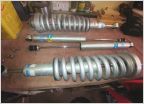-
Welcome to Tacoma World!
You are currently viewing as a guest! To get full-access, you need to register for a FREE account.
As a registered member, you’ll be able to:- Participate in all Tacoma discussion topics
- Communicate privately with other Tacoma owners from around the world
- Post your own photos in our Members Gallery
- Access all special features of the site
Quick Links: SELLING: Receiver Hitch, Firestone Airbags, More TOYOTA TACOMA 05-13 TAILGATE PLASTIC MOLDING SOLD - 2005-2015 Coverking Front Seat Cover - Rhinohide - Steel Gray - (CSCRH2TT9676) 05-15 Tacoma OEM TRD Sport Coilovers/Rear Shocks FS: SnugTop XV / Snug Top Xtra Vision- White FULLY LOADED
SELLING: Receiver Hitch, Firestone Airbags, More TOYOTA TACOMA 05-13 TAILGATE PLASTIC MOLDING SOLD - 2005-2015 Coverking Front Seat Cover - Rhinohide - Steel Gray - (CSCRH2TT9676) 05-15 Tacoma OEM TRD Sport Coilovers/Rear Shocks FS: SnugTop XV / Snug Top Xtra Vision- White FULLY LOADED  Wts Toytec 3"Lift. AFe pro dry s nib.AllPro 1.5" spacers. Dr side OEM LED Tail
Wts Toytec 3"Lift. AFe pro dry s nib.AllPro 1.5" spacers. Dr side OEM LED Tail
For Sale: Bedbugs from Tinker Troy's polyamorous petting zoo dungeon
Discussion in '2nd Gen Tacoma Parts Marketplace (2005-2015)' started by scocar, Sep 7, 2015.
Page 4 of 7
Page 4 of 7










































































